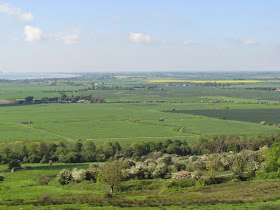It is somewhere between late spring and early summer and I am staying at an old coaching inn whose history dates back to the 14th century. It is situated just outside the ancient city walls of Canterbury whose magnificent medieval cathedral still dominates the summer skyline. The city walls or ramparts are still intact in many places around the city and my inn happens to be just outside the city walls and near the West Gate of the medieval city. The inn originally known as the White Hart is now known as the Falstaff Hotel named after the Shakespearian character. There is meant to be three ghosts but happily, as yet, I have not seen them.
 |
| The Falstaff Inn |
 |
| The West Gate and Tower |
Before we start our journey to Romney Marsh and look at beach defences of the early 19th century - a word more about our starting point. The West Gate was built by Archbishop Simon Sudbury in 1380 and replaced an earlier structure that had been built as long ago as 1023. It was at this earlier gate that William the Conqueror stopped on his way from London to Normandy in 1067 to re-confer the ancients rights and privileges afforded to Men of Kent. "Men of Kent" being those who lived South and East of the River Medway. Those who lived in the west of the county were deemed to be "Kentish Men". There is a suggestion that this ancient divide owes its origins to the fact, that in the east the settlers were mainly Jutes and to the west mainly Saxons - these Germanic tribes of Angles, Saxons and Jutes had settled in England or should we say Engel-Land the land of the Engels or Angles as written today. It was said that the Men of Kent resisted the Conqueror more strongly than did the Kentish men, but that may not be very fair on the Angles and Saxons.
The White Hart Hotel as it was then known was just outside the city walls. At night the gates to the medieval city were closed and pilgrims unable to reach the city before dark would stay at inns such as the White Hart. It was renamed the Falstaff in Elizabethan times. Sir John Falstaff appears as a corpulent knight in Shakespeare's Henry IV Parts 1 and 2.
Queen Elizabeth was so taken by this character that Shakespear included him as a central character in The Merry Wives of Windsor. To an Elizabethan audience, Falstaff would be instantly recognizable - not so today.
Nonetheless, the name has become an adjective. In dictionary.com it is described as one "having the qualities of Falstaff, especially his robust, bawdy humour, good-natured rascality, and brazen braggadocio".
"An affable Irregular,
A heavily-built Falstaffian man,
Comes cracking jokes of civil war
As though to die by gunshot were
The finest play under the sun".
(first stanza from "The Road at My Door" by William Butler Yeats (1865-1939)
As I start my journey to Romney Marsh through the English arcadia - I notice the buttercups seem more abundant than ever.
Is there anything more cheerful than a buttercup.
Is there anything more cheerful than a buttercup.
 |
| Is there anything more cheerful than a buttercup |
Perhaps only a field full of buttercups!
 |
| Perhaps only a field of buttercups |
The prickly Hawthorn bush is alive with blossom like snow in summer.
 |
| The Hawthorn in full bloom |
Romney Marsh is that low lying area of rich green grass and dykes and ditches that lies between the sea on the right, and the Saxon shoreline marked by the low line of hills that stretch from Hythe to the ragstone cliffs at Fairlight near Hastings. There's something magical and mysterious about the Marsh - sometimes described as the fifth quarter of the globe. Richard Barham in "The Ingoldsby Legends" wrote, "the world, according to the best geographers, is divided into Europe, Asia, Africa and Romney Marsh". Nonsense of course, but there is something different about the Marsh. When you are on it you see more sky because of its low lying nature and when you look inland you can see the ancient coastline of Roman Britain. Towns like Rye and Winchelsea were once islands. Inland towns like New Romney were once ports. The days of buccaneers and smugglers have gone but left their mark. The sea has retreated and today Norman churches stand on what were once little islets amongst the salt marshes. There is on the marsh an uneasy alliance between land, sea and sky.
We catch our first glimpse of Romney Marsh at Lympne - here, I am standing on the sea-cliffs of Roman Britain. Nearby there is a medieval castle and an ancient church. The castle is privately owned and said to be haunted. On a spring day, it seemed more enchanted than haunted. In Roman times, ships sailed over the shallow waters of what is now Romney Marsh to the Roman port of Portus Lemanis from which the name Lympne is derived. The Roman port was lower down the hill near and situated close to where the remains of Stutfall castle lie today. These old stone walls were part of a Roman and later Saxon fort built on the shoreline.
 |
| Lympne Castle and the remains (lower down the hill) of Stutfall Castle marking the Roman port of Portus Lemanis |
I wander into the churchyard that lies adjacent to Lympne Castle. Was there ever a more beautiful view of Romney Marsh than from this quiet spot - the church is built on the crest of the hill and in one coup d'oeil you can see the Romney Marshes stretching out to Dungeness in the glimmering haze that marks the horizon.











No comments:
Post a Comment